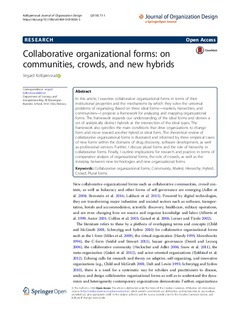Collaborative organizational forms: on communities, crowds, and new hybrids
Journal article, Peer reviewed
Published version
Permanent lenke
http://hdl.handle.net/11250/2570867Utgivelsesdato
2018Metadata
Vis full innførselSamlinger
- Publikasjoner fra CRIStin - BI [1015]
- Scientific articles [2173]
Sammendrag
In this article, I examine collaborative organizational forms in terms of their institutional properties and the mechanisms by which they solve the universal problems of organizing. Based on three ideal forms—markets, hierarchies, and communities—I propose a framework for analyzing and mapping organizational forms. The framework expands our understanding of the ideal forms and derives a set of analytically distinct hybrids at the intersection of the ideal types. The framework also specifies the main conditions that drive organizations to change form and move toward another hybrid or ideal form. The theoretical review of collaborative organizational forms is illustrated and informed by three empirical cases of new forms within the domains of drug discovery, software development, as well as professional services. Further, I discuss plural forms and the role of hierarchy in collaborative forms. Finally, I outline implications for research and practice in terms of comparative analysis of organizational forms, the role of crowds, as well as the interplay between new technologies and new organizational forms.
